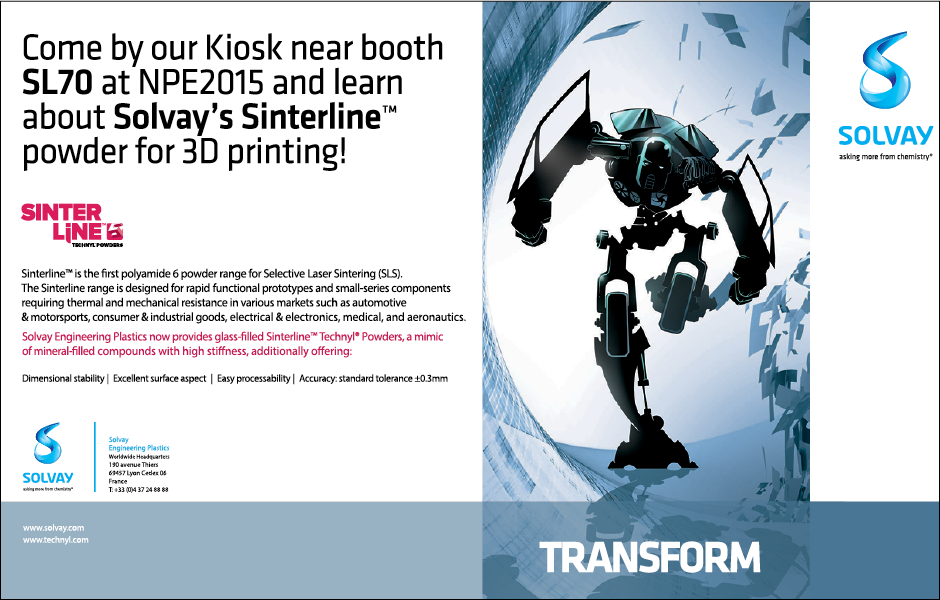By Roger Corneliussen
By Roger Corneliussen
By Roger Corneliussen
Tougher Thermosets
US Patent 8,907,049 (December 9, 2014), “Thermoset Resin Compositions with Increased Toughness,” Alexandre Baidak and Claude Billaud (Cytec Technology Corp., Wilmington, Delaware, USA).
Thermoset materials have many attractive properties such as stiffness, durability, and chemical resistance, but they are frequently brittle. Impact modifiers help, but they tend to reduce glass transition temperatures, leading to softer materials.
Baidak and Billaud developed a block copolymer impact modifier where one block (A) is a thermoplastic aromatic polymer with a glass transition temperature (T">g) of 150°C, and another block (">B) has a T">g between -130 and 40°C. ">A is soluble in the thermoset precursor, while B is insoluble. During curing, phase separation occurs, withA being dissolved in the thermoset while B forms separate nanoparticles (<100 nm) strongly connected to the matrix. A is an aromatic polymer such as a polyether sulfone, and B is an aliphatic polyester. B be should less than 50 wt% of the aromatic component.
“Comb” Copolymers
US Patent (December 9, 2014), “Comb Architecture Olefin Block Copolymers,” Phillip D. Hustad, Endre Szuromi, Francis J. Timmers, Edmund M. Carnahan, Thomas P. Clark, Gordon R. Roof, Sara B. Klamo, and Daniel J. Arriola (Dow Global Technologies LLC, Midland, Michigan, USA).
Olefin block copolymers can have a unique balance of flexibility, heat resistance, and recovery properties; however, their melt processability remains a problem. Hustad et al. polymerized ethylene and other monomers with two catalysts and a chain shuttling agent. The resulting copolymer has a soft backbone with hard, crystalline side chains. These “comb” copolymers are blended with ethylene and propylene homopolymers or their copolymers with more than 50 mol% ethylene. Their comb branches have 98 wt% ethylene.
Vacuum Testing
US Patent 8,904,887 (December 9, 2014), “Radio Frequency Transparent Thermal Window,” Michael A. Tockstein, James P. Nokes, Jon V. Osborn, Dhruv N. Patel, Alan R. Hopkins, John S. Williams, and Gary N. Harper (The Aerospace Corp., El Segundo, California, USA).
Manufacturers of electronic components for spacecraft have developed various methods and test chambers for simulating space-like conditions for testing. However, vacuum and thermal chambers typically are made of metals, which interfere with radio signals.
Tockstein et al. developed radio frequency-transparent windows having internal conduits for cooling. Both
the pressure and thermal windows
are formed from material that is radio frequency-transparent, preferably polycarbonate materials.
Oxygen Scavenging
US Patent 8,906,299 (December 9, 2014), “Scavenging Oxygen,” Mark Rule, Ronald J. Valus, and Steven Burgess Tattum (Colormatrix Holdings, Inc., Wilmington, Delaware, USA).
Food oxidation restricts food storage lifetimes in containers. All polymers have some permeability to oxygen, limiting these lifetimes. Internal oxygen content can be reduced by chemical scavengers; however, scavengers have slow rates of reaction, limited capacity, and limited ability to trigger the scavenging reaction at the time of filling. Immediate scavenging during filling is necessary to prevent sidewall hazing and discoloration.
Rule, Valus, and Tattum developed an oxygen scavenger for containers containing a wall-embedded palladium catalyst and a closure containing a hydride. When the closure contacts water vapor, molecular hydrogen is released which combines with oxygen and catalysts in the wall to form water, thus protecting the contents of the container as well as the wall itself.
Cooler Buildings
US Patent 8,906,272 (December 9, 2014), “Infra-Red Reflective Material and Production Method thereof, and Paint and Resin Composition containing the same,” Yoichi Takaoka, Norihiko Sanefuji, and Emi Ohta (Ishihara Sangyo Kaisha, Ltd., Osaka, Japan).
Infrared reflective materials reflect infrared rays from sunlight or other heat sources. These infrared reflective materials can increase the air conditioning efficiency of buildings in summer by reducing radiation heating of asphalt, concrete, and other building materials. However, most reflective fillers are oxides of toxic chromium. Other reflective oxides are soluble in water, and expensive.
Takaoka, Sanefuji, and Ohta developed infrared reflective fillers for plastics and paints consisting of perovskite-like multiple oxides. These complex oxides of alkaline earth metal elements and titanium, zirconium, or niobium and have high infrared reflectivity after firing. They also have high thermal stability and heat resistance, and are non-toxic because of the absence of chromium. These oxides are also water-insoluble and resist long-term elution.
Polymers from Waste Cooking Oil
US Patent 8,895,689 (November 25, 2014), “Production of Polymers from Waste Cooking Oil,” Thomas John Melnyk and Gregory B. Hayes (Valspar Sourcing, Inc., Minneapolis, Minnesota, USA).
Deep frying in fast-food restaurants leads to large amounts of wastes, such as contaminated cooking oil. Melnyk and Hayes formed an alkyd resin by reacting waste cooking oil with polycarboxylic acids and polyols. The resulting alkyd resins are used in a variety of coatings, including paints, varnishes, lacquers, and baked enamels. Suitable polyols for use in the present invention include difunctional and trifunctional alcohols, and the acids include aliphatic and aromatic polycarboxylic acids and their esters. The resulting alkyds have a range of hydroxyl and acid numbers.
Making Polymers Degradable
US Patent 8,895,673 (November 25, 2014), “Macromonomers for Preparation of Degradable Polymers and Model Networks,” Jeremiah Johnson, Jeffrey T. Koberstein, and Nicholas J. Turro (Columbia University, New York, New York, USA).
A degradable polymer is a polymer that contains a reactive cleavage site that will break, reducing molecular weight and forming new groups under certain conditions. Polymers based on a C-C backbone tend to be stable and non-degradable, while hetero-atom backbones are degradable. Degradability can therefore be engineered into polymers by the addition of chemical linkages such as anhydride, ester, or amide bonds.
Johnson, Koberstein, and Turro, using atom transfer radical polymerization (ATRP) and click chemistry, synthesized degradable network polymers for specific degradation reactions. ATRP was used to synthesize difunctional macromonomers. Terminal groups included halides, which were then converted into hydroxyl, allyl, acrylate, or azide functional groups. The networks were then polymerized with the appropriate curing agent and degraded by ozone or radiation.
Suspension Dispersion
US Patent 8,916,627 (December 23, 2014), “Methods and Devices for Continuous Production of Polymeric Dispersions,” Bruce Edward Wade, Witold Szydlowski, Mike Yi Ren Chen, and Stefaan Maurice Florquin (Solutia Inc., St. Louis, Missouri, USA).
Suspensions are widely used in coatings and compounding; however, dispersion methods are time-consuming and energy-intensive. New rapid and economical suspension methods are needed.
Wade et al. used continuous extrusion to form high-quality polymer dispersions of polyvinyl butyral, a surfactant, and a plasticizer. They used a screw extruder to inject water into a zone of high pressure, temperature, and shear to cause rapid dispersion in less than one minute.
Nanotube Insulation
U.S. Patent 8,911,860 (December 16, 2014), “Electrically Insulating Material, Particularly for High Voltage Generator,” Hans Jedlitschka (General Electric Co., Schenectady, New York, USA).
Numerous electrically insulating materials have been developed, particularly to ensure the insulation of high-voltage generators supplying, for example,
X-ray tubes used in medical imaging. A popular dielectric material in use today is polypropylene filled with talc. However, new technology requires better insulation for higher voltages.
Jedlitschka developed improved
insulation based on polymeric nanocomposites consisting of polypropylene or polyethylene filled with less than
1 wt% of carbon nanotubes. In addition, generator cooling is more efficient because of the carbon nanotubes. The insulation/cooling combination of effects makes it possible to reduce generator size and weight.

